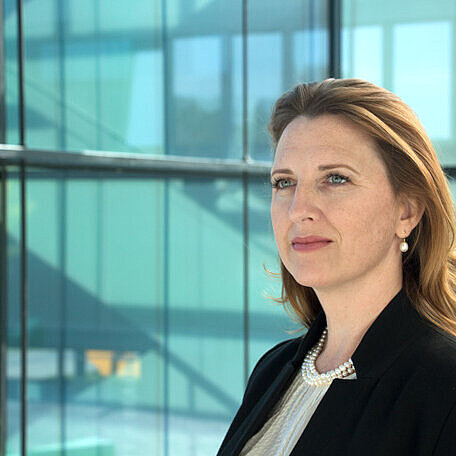Quantum Computational Fluid Dynamics
Archimedes said, "give me a place to stand, and I shall move the earth" (δός μοι πᾷ στῶ καὶ τὰν γᾶν κινήσω) when he explained the lever principle. Nowadays some people say, “with enough computational power, we could predict the future.” With this in mind, Professor Helena Liebelt and Professor Rui Li, aided by a team of young researchers, are combining advanced computational fluid dynamics (CFD) with quantum systems.
The aim is to understand the transport phenomena of fluid mechanics, with water and air the most common fluids dealt with in everyday life. Since the ability generate simulations is limited by computing power, quantum computing, with its enormous computational capacity, is likely to benefit predictions based on computational fluid dynamics. As an example, weather data, such as sunshine intensity, air temperature, air pressure, and cloud and droplet distribution, are put into computer simulations, which include computational fluid dynamics, to predict future weather forecasts. CFD simulations could therefore be used to provide more reliable weather forecasts in future, leading to advances in meteorology.


An example of three fundamental approaches used in the study and analysis of engineering systems based on liquid sloshing.
Theory, Experiment, Computing
Three fundamental approaches define the study and analysis of engineering systems: theory, experiment and computing. How these approaches combine can be shown through the example of liquid sloshing. "Liquid sloshing is a typical phenomenon where liquid in a container has an unrestrained surface. The sloshing process causes the fluid to land on structures and walls, which can lead to structural damage and other problems," says Li. "Liquid sloshing can also have other dangerous consequences. For example, it can have an impact on the safety performance of oil tank vehicles, as when a vehicle breaks or slows down on the highway, which can lead to a significant increase in pressure. In the case of a molten nuclear reactor, sloshing can be catastrophic" Li adds. The image below shows the Bell-Plesset instability of water using the three approaches of theory, experiment and computing, which all agree with each other in the case of sloshing. When the system involves fluid flow, the numerical simulation—that is, computational fluid dynamics (CFD)—is devoted to solving the differential equations by using supercomputers, such as a high performance computer with parallelization.
CFD Simulations in Daily Life
Conducting experiments is usually very expensive, and in some cases they are not possible to do for safety reasons, as is often the case in the nuclear industry. Engineers therefore use both experiments and computational fluid dynamics, with the two complementing each other, as is the case when both are used to prepare for launching a space shuttle into outer space.


Fluid dynamics has unlimited practical applications ranging from microscopic biological systems to automobiles, airplanes, and spacecraft propulsion. "Flows, whether air or fluid based or otherwise, are everywhere. We live with many kinds of flows," says Li, adding that "computational fluid dynamics can be used to clearly predict the behavior of flows, providing much insight into what happens around us." Simulation therefore plays an important role not only in science and engineering but also in our daily life. With the help of computational fluid dynamics, the trajectories of aerosols of corona virus can be clearly reproduced, for example, clearly showing why social distancing during the pandemic has been set at 1.5 meters.
The Leibniz Supercomputing Centre and the Deggendorf Institute of Technology (DIT)
As the most promising future technology with the most advanced computational power, the quantum system could bring numerical simulation into an exciting new era. DIT master students and researchers are therefore currently carrying out quantum computational fluid dynamics experiments (QCFD) combining CFD algorithms with quantum systems. Benefiting from a cooperation with Intel, the quantum simulator SDK has been adopted to solve partial differential equations.
Thanks to the Bavarian QCFD platform, simulations can be performed with the quantum system at the Leibniz Supercomputing Centre near Munich. Ambitious young researchers are eager to study how closely quantum computers can handle the famous Navier-Stokes equations, which still remain a mystery.
Universities of Applied Sciences
Find out about this special type of university and how to connect!
- What is a University of Applied Sciences?
- Getting to know Universities of Applied Sciences as a visiting researcher
- Doing your PhD or becoming a professor at a University of Applied Sciences

DIT Nurtures Computational Fluid Dynamics Technology
The application of computational fluid dynamics is nevertheless only the tip of the iceberg when it comes to computing requirements. The fields of both high-performance computing and quantum computing are becoming increasingly important in today’s world, as we rely on large scale data processing for solving increasingly complex problems. It’s therefore no surprise that the market for high performance and quantum computing is increasing, especially as a result of the pandemic, with the field also gaining increasing public interest both in Germany and internationally.
Mixed teams are more innovative and successful. Diversity also includes collaboration: working with very different people and engaging with other people’s perspective.Prof. Helena Liebelt, Head of IT, Program Coordinator for High Performance Computing / Quantum Computing, Deggendorf Institute of Technology (DIT)
In response to these developments, Deggendorf has introduced the future-orientated master’s program "High-Performance Computing / Quantum Computing". The program is taught in English and therefore provides an excellent international study and research environment for postgraduates. It actively collaborates with quantum computing experts within the academic community as well as within industry. If you are interested in a career in quantum computing research, the Deggendorf Institute of Technology offers an internationally diverse and challenging research environment.

Professor Dr. Rui Li has published 13 international journal articles as the first author and contributed 5 deliverables to the European Commission. Professor Li previously worked at the Tokyo Institute of Technology and the Karlsruhe Institute of Technology before developing his career at the Deggendorf Institute of Technology, where he specializes in physics, thermodynamics, numerical simulation, and nuclear safety.



